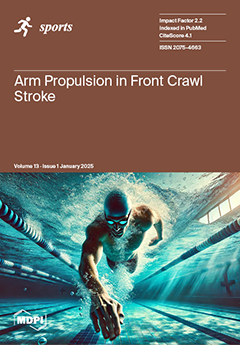Background: This study aimed to investigate the effects of a 12-week body-weight-based resistance training program on balance ability and fear of falling in community-dwelling older women. Methods: Twenty-three older women were assigned to either an intervention group that performed the low-load resistance training with slow movement using the body weight (LRT group;
n = 12) or a control group (CON group;
n = 11). The LRT group participated in the exercise session twice weekly for 12 weeks, while the CON group maintained their daily routine. The 30 s chair stand test (CS-30) was applied to measure lower-extremity muscle strength, balance ability was evaluated using one-leg standing tests with eyes open (OLST-O) and closed (OLST-C), and fear of falling among all participants was assessed using the Falls Efficacy Scale International (FES-I) before (pre) and after (post) the intervention. A two-way analysis of variance with repeated measures [group (LRT and CON) × time (pre and post)] was carried out to evaluate the intervention effects. Results: Significant interactions were observed in the CS-30 (F = 9.503,
p < 0.01,
= 0.312), OLST-O (F = 5.211,
p < 0.05,
= 0.199), and OLST-C (F = 5.257,
p < 0.05,
= 0.200), though significant simple main effects from pre to post were observed only in the LRT group. The CS-30 scores (pre: 19.8 ± 3.8 times, post: 25.5 ± 5.6 times;
p < 0.001), OLST-O time (pre: 78.8 ± 35.8 s, post: 96.2 ± 29.9 s;
p < 0.01), and OLST-C time (pre: 10.2 ± 5.9 s, post: 17.4 ± 12.2 s;
p < 0.01) were improved before and after the intervention. However, a significant interaction was not observed in FES-I (F = 1.335,
p = 0.261,
= 0.06). Conclusions: The 12-week body-weight-based resistance training program enhanced lower-extremity muscle strength and balance ability but did not lessen the fear of falling in community-dwelling older women. The study findings offer relevant information for fall prevention in older adults.
Full article






